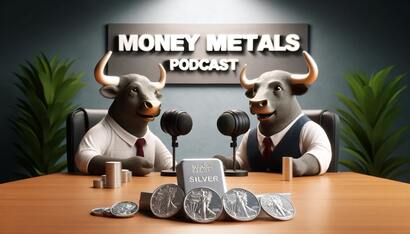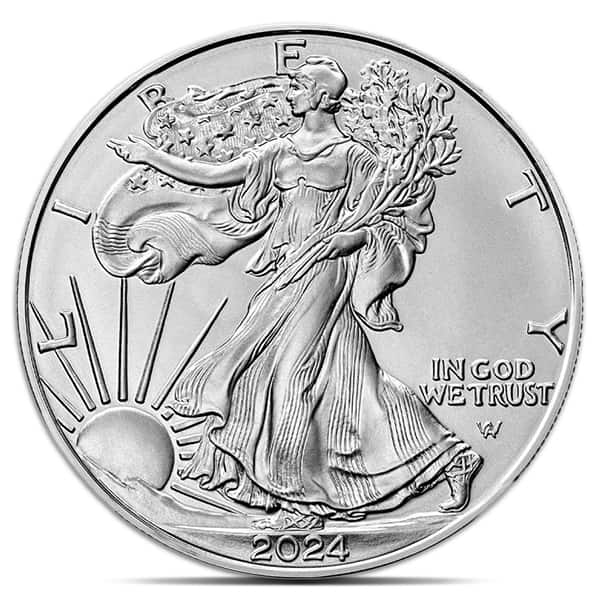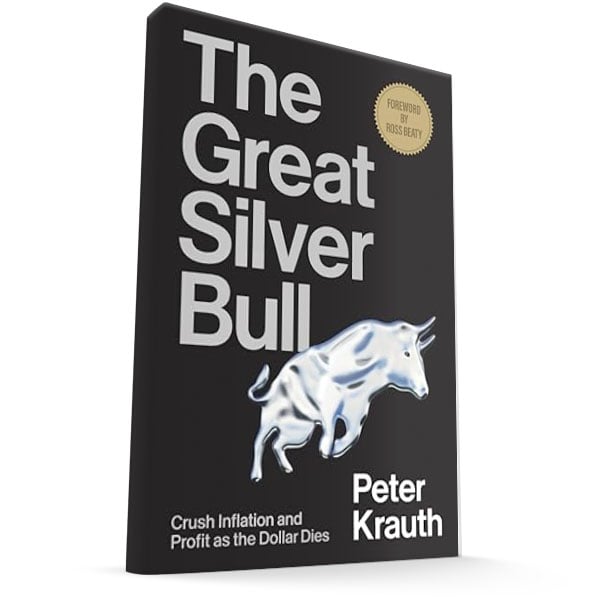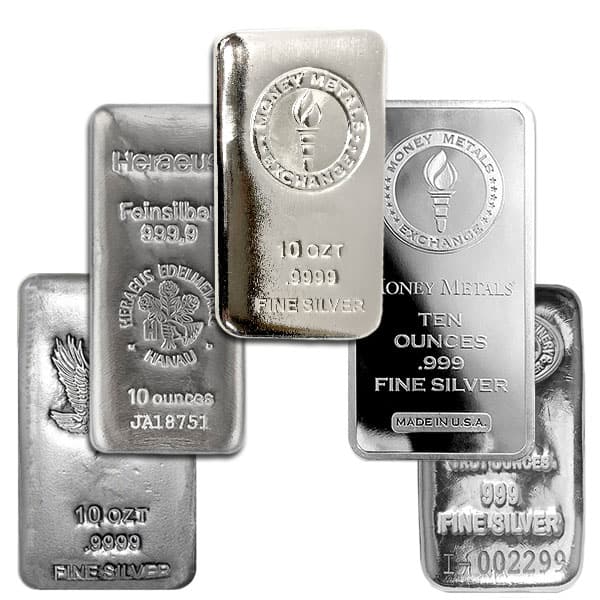In a recent interview on the Money Metals podcast, host Mike Maharrey sat down with Peter Krauth, a seasoned precious metals expert and author of The Great Silver Bull.
During their discussion, Krauth shared valuable insights on the current and future state of the silver market, highlighting its role as an undervalued investment, the dynamics of the gold-silver ratio, supply and demand challenges, and the potential impact of economic policy on precious metals.
(Interview Begins Around 6:34 Mark)
Peter Krauth
Peter Krauth is a seasoned metals analyst and expert in the resource market, with over 20 years of experience specializing in precious metals, mining, and energy stocks. He is the editor of the investment newsletter Silver Stock Investor, which focuses exclusively on silver investments.
Silver’s Price Trajectory: Perceptions vs. Reality
Krauth acknowledged the perception that silver lags behind gold in performance. While gold reached 38 new record highs this year, with prices rising by 38% since mid-February, silver has outperformed gold with a 46% gain during the same period.
Krauth emphasized that while silver may often appear as a “laggard” early in a bull market, it historically outpaces gold in the long run, driven by industrial demand and investor interest during periods of market stress.
The Gold-Silver Ratio and What It Signals
The gold-silver ratio, hovering around 83 to 84:1 in recent months, is notably higher than the historical range of 40 to 60:1. This indicates that silver remains relatively undervalued compared to gold, a situation Krauth views as an opportunity for investors.
Despite silver’s gains, the high ratio is partly maintained by gold’s strength and persistent investor interest. Krauth advised keeping a close eye on the gold-silver ratio, as it reinforces silver’s undervaluation and offers a potential entry point for long-term investors.
Supply Deficits: A Key Factor in Silver’s Potential Upswing
One of the more pressing issues Krauth discussed is the silver supply deficit. Over the past three years, silver demand has exceeded supply, driven by an expanding industrial demand—particularly in electronics, solar panels, and electric vehicles. The silver market operates with an annual supply of around 1 billion ounces, 85% from mining and 15% from recycling.
Yet, annual demand has surged to 1.2 billion ounces, creating a 200-million-ounce shortfall, currently covered by existing stockpiles. Krauth predicts that these reserves will deplete within the next 12 to 18 months, which could result in supply constraints and significant price increases if demand remains high.
Industrial Demand: The Steady Floor Under Silver Prices
Industrial demand for silver is strong and growing, with uses across various fields. According to Sprott Investment Management, silver ranks second only to oil in terms of its global applications, spanning electronics, medical applications, and renewable energy.
Notably, in 2024, industrial demand is expected to represent 70% of total silver supply, up from 50% just a few years ago. With renewable energy mandates in many countries, demand from solar panel manufacturing alone accounts for over 20% of global silver consumption.
Parallels with Uranium: Potential for a Strong Price Rally
Krauth drew an intriguing comparison between silver and uranium markets. Like silver, uranium faced a period of high demand and limited supply, with secondary sources filling the gap until they dwindled, leading to a price surge from $23 to $83 per pound over three years.
Krauth sees similar dynamics in silver, where above-ground stockpiles are shrinking, and new supply is limited. He anticipates a price rally in silver, propelled by industrial demand and the eventual depletion of available stockpiles.
Global Factors Influencing Silver: India and Russia
India’s surging silver demand also plays a critical role. The country recently cut import duties on silver, resulting in a fivefold increase in silver imports in Q3 2023 compared to the same period in 2022. India’s expanding solar panel production and cultural affinity for silver jewelry are driving this demand.
Krauth also highlighted Russia’s decision to include silver in its national wealth fund, potentially to support domestic industries and accumulate silver as a strategic asset. Krauth views these developments as additional positive drivers for silver prices.
Policy and Precious Metals: Harris vs. Trump
Looking at the broader economic landscape, Krauth discussed how a potential presidency by either Harris or Trump might influence precious metals. He believes silver and gold are poised to rise regardless of who holds office, as government spending and debt continue to escalate.
While a Harris administration may prioritize renewable energy initiatives that could bolster silver demand, a Trump presidency may favor deregulation and support for mining industries. Both scenarios, Krauth argues, would contribute to a bullish environment for precious metals.
Final Thoughts and The Great Silver Bull
In closing, Krauth recommended his book, The Great Silver Bull, which explores the factors driving the silver market and offers a generational investment perspective. Through short, digestible chapters, Krauth provides insights into silver’s economic fundamentals, its role in portfolio diversification, and strategic approaches for investing in both physical silver and mining stocks.
For those interested in precious metals, Krauth’s comprehensive analysis of silver’s unique market dynamics, historical context, and future potential offer a roadmap for understanding this often-overlooked asset. As the world faces rising demand for renewable energy and geopolitical shifts, silver stands as a compelling investment with substantial growth potential.
Key Questions & Answers

Here are the key questions and answers from the podcast interview between Mike Maharrey and Peter Krauth:
Is silver a laggard compared to gold?
Yes, silver is often perceived as a laggard in bull markets, but it ultimately outperforms gold, especially in the later stages of a bull market. Despite gold reaching record highs this year, silver has actually outpaced gold in percentage terms, with a 46% increase since February compared to gold’s 38% gain. Silver tends to be back-end loaded in bull markets, where its performance accelerates towards the end.
How does the gold-silver ratio affect the silver market?
The high gold-silver ratio, recently around 83 to 84:1, indicates that silver remains undervalued compared to gold. This is an opportunity for investors, as silver is historically undervalued when the ratio is high. The high ratio reinforces silver’s appeal as a long-term investment and reflects its relative affordability against gold.
What impact does the silver supply deficit have on future prices?
With silver demand outstripping supply by 200 million ounces annually, covered by existing stockpiles, there are significant price increases likely once above-ground reserves are depleted. These reserves may run out within the next 12 to 18 months, creating potential for a price rally, especially if demand from industrial uses remains high.
How does industrial demand influence silver prices?
Industrial demand for silver is strong and rising, accounting for around 70% of supply in 2024, compared to 50% in previous years. Silver is essential in electronics, solar panels, electric vehicles, and medical applications, creating a steady demand base. This robust industrial demand will provide a stable floor under silver prices.
Are there similarities between the silver and uranium markets?
There are similarities between silver and uranium markets, where high demand and limited supply eventually led to a price surge in uranium. Similar dynamics are seen in silver, with above-ground stockpiles being drawn down and limited new supply, which could lead to a significant price rally for silver in the future.
How is India influencing the silver market?
India has become a major silver buyer, recently reducing import duties, which led to a fivefold increase in Q3 2023 silver imports compared to 2022. India’s demand for silver is driven by industrial uses like solar panels, cultural jewelry demand, and its bargain-hunting culture as gold prices rise.
What does Russia’s inclusion of silver in its wealth fund mean for the market?
Russia’s decision to include silver in its wealth fund is strategic, possibly to support its domestic industries and accumulate a valuable asset. This move may restrict silver supply on the global market and reflects the geopolitical importance some countries place on silver.
How would a Harris or Trump presidency affect silver and gold markets?
Both candidates would likely drive precious metals prices higher due to continued government spending. A Harris administration may increase renewable energy demand, benefiting silver, while a Trump presidency may favor deregulation and support mining industries. Either outcome would likely have a positive impact on precious metals.
Why should investors consider Krauth’s book, The Great Silver Bull?
The book explores silver as a “generational opportunity” and provides insights into its economic fundamentals, investment potential, and strategies for physical silver and mining stocks. Written in a straightforward, accessible format, it helps investors understand silver’s market dynamics and the factors that influence its long-term value.
Become a Patron!
Or support us at SubscribeStar
Donate cryptocurrency HERE
Subscribe to Activist Post for truth, peace, and freedom news. Follow us on Telegram, HIVE, Minds, MeWe, Twitter – X and Gab.
Provide, Protect and Profit from what’s coming! Get a free issue of Counter Markets today.





Be the first to comment on "Understanding the Bullish Case for Silver: Insights from Peter Krauth"